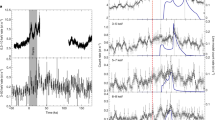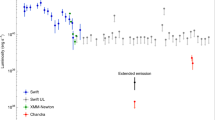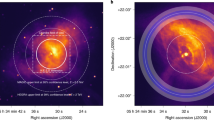Abstract
THE X-ray source in the Crab Nebula appears as a composite system consisting of a diffuse source about 2 minutes of arc in diameter1,2, and a pulsating source synchronous with the radio and optical pulsar NP 0532 (refs. 3–6). It has been suggested that the X-rays received from the Crab could in fact all be released by the central star7, and that the apparent extended source could be due to the scattering of X-rays by interstellar dust particles which are also believed to be responsible for stellar extinction and reddening. The typical scattering angle for a photon of wavelength λ impinging on a dielectric obstacle of size a is of order λ/a, that is, minutes of arc for photons of a few keV and micron sized grains, and close to the angular extension of the diffuse source. Following this idea, one can assume that any X-ray photon received from the Crab was emitted during the pulses, but scattering by an angle as low as 0.1 second is sufficient to increase the travel time to the Earth by more than one pulsar period (0.03 s), thus hiding the pulsating character of the source8. (The photon detected within the pulses would have suffered no scattering at all.) A typical amount of interstellar dust could indeed explain the relatively low fraction (0.05 to 0.015 per cent, refs. 3 to 6) of the power received within the pulses.
This is a preview of subscription content, access via your institution
Access options
Subscribe to this journal
Receive 51 print issues and online access
$199.00 per year
only $3.90 per issue
Buy this article
- Purchase on Springer Link
- Instant access to full article PDF
Prices may be subject to local taxes which are calculated during checkout
Similar content being viewed by others
References
Bowyer, S., Byram, E. T., Chubb, T. A., and Friedman, H., Science, 146, 912 (1964).
Oda, M., Bradt, H., Garmire, G., Spada, G., Sreekantan, B., Gursky, H., Giacconi, R., Gorenstein, P., and Waters, J. R., Astrophys. J. Lett., 148, L5 (1967).
Fritz, G., Henry, R. C., Meekins, J. F., Chubb, T. A., and Friedman, H., Science, 164, 709 (1969).
Bradt, H., Rappaport, S., Mayer, W., Nather, R. E., Warner, B., Macfarlane, M., and Kristian, J., Nature, 222, 728 (1969).
Boldt, E. A., Desai, U. D., Holt, S. S., Serlemitsos, P. J., and Silverberg, R. F., Nature, 223, 280 (1969).
Ducros, G., Ducros, R., Rocchia, R., and Tarrius, A., CR Acad. Sci., Serie B, 269, 932 (1969).
Bowyer, S., Byram, E. T., Chubb, T. A., and Friedman, H., Science, 146, 912 (1964).
Slysh, V. I., Nature, 224, 159 (1969).
Overbeck, J. W., Astrophys. J., 141, 864 (1965).
Van de Hulst, H. C., Light Scattering by Small Particles (Wiley, 1957).
Allen, C. W., Astrophysical Quantities (Athlone Press, 1964).
Boldt, E. A., Desai, U. D., and Holt, S. S., Astrophys. J., 156, 427 (1969).
Floyd, F. W., Glass, I. S., and Schnopper, H. W., Nature, 224, 50 (1969).
Fishman, G. J., Harnden, F. R., and Haymes, R. C., Astrophys. J. Lett., 156, 427 (1969).
Hillier, R. R., Jackson, W. R., Murray, A., Redfern, R. M., and Standing, K. G., Nature, 222, 149 (1969).
Hiltner, W. A., Astrophys. J. Supp., 2, 389 (1956).
Van de Hulst, H. C., Rech. Astronom. Obs. Utrecht, 11, 43 (1949).
Author information
Authors and Affiliations
Rights and permissions
About this article
Cite this article
RYTER, C. Physical Sciences: Scattering of X-Rays from the Crab Nebula. Nature 226, 1040–1041 (1970). https://doi.org/10.1038/2261040a0
Received:
Issue Date:
DOI: https://doi.org/10.1038/2261040a0
This article is cited by
-
The crab nebula
Astrophysics and Space Science (1973)
-
X-Ray Observations of Pulsars
Nature Physical Science (1971)
-
Pulsations in the X-radiation of the Crab Nebula
Nature (1970)
Comments
By submitting a comment you agree to abide by our Terms and Community Guidelines. If you find something abusive or that does not comply with our terms or guidelines please flag it as inappropriate.



